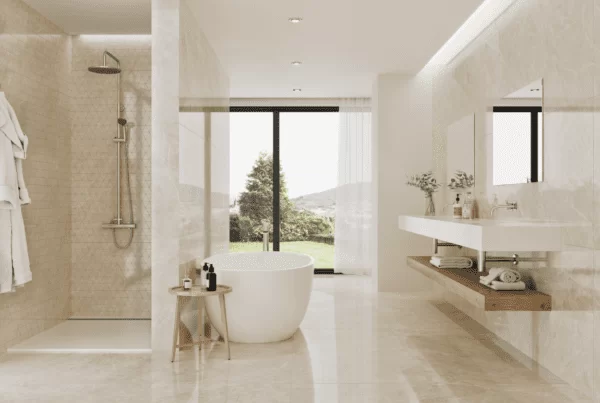Which is better and more practical to use for the outdoors?
Natural Stones, most commonly Granite and Limestone, have been used to tile the outdoor patios and driveways in homes and offices for centuries now. They are well known for their beauty and elegance when installed. They are quarried from various quarrying and mining sites, in large blocks, then taken to a specialised site in order to be cut and shaped into regularly sized slabs, and so then they can either become polished (shiny finish on the surface) or honed, which gives the slab a matt texture to remain natural feeling and very simple looking, not too much in your face. They also have many useful features and characteristics that make them exceptionally good for their role, as they are generated by nature, and are found in nature too. For example, they are very durable and resistant to extreme weather conditions, and we do not have to mention how beautiful and exotic some stones are, that they bring the whole space to life. However, as technology has progressed and stone has moved on, we have recently had porcelain tiles introduced into the market of flooring and stone. Initially, porcelain tiles were only used for indoor rooms and offices, however as manufacturers started experimenting and becoming creative, at some point they even managed to produce outdoor porcelain tiles, that are also equally as suitable for patio and driveway use as natural granite, limestone and other natural stones are.
Porcelain is made from a certain mixture of silica, various white powdered clay, feldspar, flint materials, and very minute quantities of other such small particles. These are all extracted from various sites around the country, however these are all materials that can easily be taken, as they are widely available, and they do not require any highly technical machinery and do not require a set up of a mining or quarry site for example. They are then transported to the manufacturing sites, which can be easily done in large quantities as these raw materials are not too heavy at all. At the specialised sites, they are then ground into fine powder, and then mixed in with each other, with a huge amount of water – in order to ease the mixing – after which they are pressed into large moulds of the desired sizes and shapes. The shaped moulds are then compressed under very high pressure, and they are placed into a large furnace, exposed to extreme temperatures of around 1,200 degrees Celsius. This is to ensure that all the excess water is removed from the mixture, and to make sure that the mould is compressed and heated very well to become very tightly and strongly held together. The mould is then taken out after a while, and left to cool down, soon after which the tiles are glazed with various digital designs, print and colours, before the new surface is either polished or finished off in a matt texture.
As a result of porcelain being a product that is manufactured using materials that are widely abundant, and easy to get hold of (and so therefore not very valuable or expensive), porcelain tends to be cheaper than natural, when comparing like for like. Consequently, even with a strict budget, you can go for a larger tile in porcelain, which would look much more glamorous and elegant, for the same price you would pay for a much smaller tile in natural stone. Plus, as we mentioned, the raw materials used in porcelain are relatively light, to the point that even when they are compressed so tightly into the moulds to produce the porcelain tiles, they still weigh less than a similar sized natural stone piece would weigh. In turn, this then means that it would be much easier to install, and so it would cost less to get a tiler to do the fitting and laying.
Another unique selling point that the porcelain has is that it is compressed very tightly using very high pressures during the manufacturing process. This fact might not seem relevant to your preferences and requirements, but this point actually makes a huge difference. The fact of the matter is that when porcelain is compressed and heated in such a manner, it ensures that it gets rid of any possible pores that may form on the surface (and especially none on the inside). Firstly, this makes porcelain very stain resistant, as it is very difficult for any liquids to drain into the stone and cause discolouration. Therefore, if you choose to go for porcelain tiles, then you can rest assured that heavy rain, moisture or even spillages are not going to affect the look of porcelain, nor damage its beauty. Furthermore, it also ensures that there is no place for any tiny moss plants to start growing in, and give an unpleasant look and texture to the stone tiles. Therefore, with regards to natural stone, a lot of maintenance work is required such as regular deep and extensive cleaning, and regular sealing using a specialised greasy material, to try to reduce the size of the pores found in the natural stones, but they still cannot be sealed perfectly, and so there will still be some discolouration noticeable much quicker than in porcelain…so porcelain requires much less maintenance and provides much more peace of mind simultaneously.
Porcelain also comes in many different sizes, colours, designs, thicknesses and many more factors of variation. This means that no matter what you want to imagine your tiles to be like, you will most probably find something very similar (if not exactly matching) to your preference and imagery. We can see therefore that although natural stone is great for use outdoors, and it has been the most popular choice for outdoor flooring and paving and tiling, but fortunately as methods have developed, manufacturers have created a stone that is even greater than natural stone, and even more suitable for such use…called porcelain!



